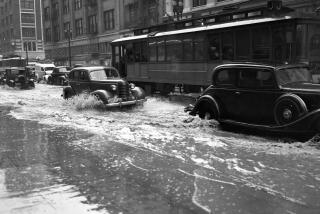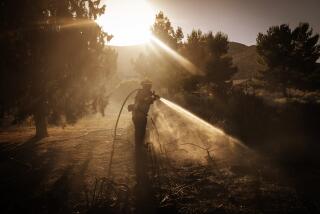Asian air pollution affects our weather
Asia’s growing air pollution -- billowing plumes of soot, smog and wood smoke -- is making the Pacific region cloudier and stormier, disrupting winter weather patterns along the West Coast and into the Arctic, researchers reported Monday.
Carried on prevailing winds, the industrial outpouring of dust, sulfur, carbon grit and trace metals from booming Asian economies is having an intercontinental cloud-seeding effect, the researchers reported in the Proceedings of the National Academy of Sciences.
The study is the first large-scale analysis to draw a link between Asian air pollution and the changing Pacific weather patterns.
“The pollution transported from Asia makes storms stronger and deeper and more energetic,” said lead author Renyi Zhang at Texas A&M; University. “It is a direct link from large-scale storm systems to [human-produced] pollution.”
Satellite measurements reveal that high-altitude storm clouds over the northern Pacific have increased up to 50% over the last 20 years as new factories, vehicles and power plants in China and India spew growing amounts of microscopic pollutant particles into the air.
The resulting changes have altered how rain droplets form and helped foster the creation of imposing formations over the northern Pacific known as deep convective clouds.
The clouds create powerful updrafts that spawn fiercer thunderstorms and more intense rainfall, particularly during the winter, the researchers said.
Only a decade ago did scientists in the University of California’s Pacific Rim Aerosol Network help discover that the pollution crossing the Pacific from Asia was worse than suspected, with millions of tons of previously undetected contaminants carried on the wind.
In fact, on any spring or summer day, almost a third of the air high over Los Angeles, San Francisco and other California cities can be traced directly to Asia, researchers said.
“More stuff starting up over there means more stuff ending up over here,” said UC Davis atmospheric scientist Steven Cliff.
Usually, dust and industrial pollutants take from five days to two weeks to cross the Pacific to California.
Zhang and his colleagues conducted their three-year study by comparing satellite imagery of the Pacific region taken from 1984 to 1994 with imagery of the same area from 1994 to 2005. The study, funded by NASA and the National Science Foundation, found that deep convective clouds had increased between 20% and 50%.
Convective clouds include cumulonimbus clouds, which can be many miles thick with a base near Earth’s surface and a top frequently at an altitude of 33,000 feet or more.
The research team, which included atmospheric scientists from Caltech, the Massachusetts Institute of Technology, NASA’s Jet Propulsion Laboratory and UC San Diego, linked the changing cloud patterns to the increasing pollution through a series of computer studies.
The scientists also examined satellite data from the Atlantic region during the same periods, since pollution from North America follows the prevailing winds to Europe. But they did not find any similar pattern of cloud changes or increase in storm intensity.
The Pacific pollution also may affect other pervasive patterns of air circulation that shape world climate.
“If the trend to intensified storms in this region persists, it will likely have profound implications on climate change,” said Robert McGraw, a senior atmospheric chemist at Brookhaven National Laboratory on Long Island, who was not involved in the study.
Among other consequences, the more energetic Pacific storm track could be carrying warmer air and more black soot farther north into the Canadian Arctic, where it may accelerate the melting of polar ice packs, the researchers said.
The researchers emphasized that it would take much more sustained study to understand the international climate ramifications.
Until recently, most scientists believed that, with its adverse effects on health and plant life, such aerosol pollution was mostly a local problem. If anything, it helped rather than hindered the climate -- at least in terms of global warming -- by offsetting the heat-trapping effects of greenhouse gases such as carbon dioxide and methane.
At low altitudes, the haze of aerosol particles reflects the sun’s energy back into space, cooling Earth’s surface slightly. At the same time, the particles help form brighter low-altitude clouds that also shield the surface from solar heat.
But once these tiny particles reach the upper atmosphere, they generate fierce downpours from super-cooled droplets and ice particles instead of gentle warm showers.
At monitoring sites along the U.S. West Coast, scientists have been detecting pollutants that originated from smokestacks and tailpipes thousands of miles to the west.
Recently, researchers at the University of Washington have captured traces of ozone, carbon monoxide, mercury and particulate matter from Asia at monitoring sites on Mt. Bachelor in Oregon and Cheeka Peak in Washington state.
Cliff and his colleagues have been picking up the telltale chemical signatures of Asian particulates and other pollutants at several monitoring sites north of San Francisco and, during the last year, around Southern California.
The pollutants, however, are suspended at high altitude. It is unclear how much of them reach ground level or what their direct effect on local weather might be.
“The air above Los Angeles is primarily from Asia,” Cliff said. “Presumably that air has Asian pollution incorporated into it.”
*






